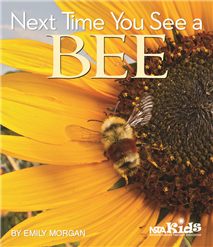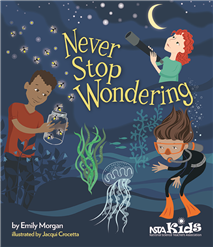Two NSTA Books Encourage Young Readers to Keep Questioning, Searching, and Expressing Wonder
By Carole Hayward
Posted on 2019-07-20
NSTA Press author Emily Morgan wants young readers of her books to be filled with a sense of wonder about ordinary objects or phenomena—like bees—and to never stop exploring the “whys” of our natural world.
Two books that every K-5 teacher should add to their classroom collections are Never Stop Wondering and Next Time You See a Bee.
Jacqui Crocetta’s engaging illustrations bring Morgan’s delightful rhymes to life in Never Stop Wondering, which implores its readers to keep questioning, searching, and trying to figure things out, because, “That is what science is all about.”
Students are introduced to physician and mathematician Sir Isaac Newton; astronaut Dr. Mae Jemison; and oceanographer Dr. Sylvia Earle. Morgan encourages her readers to emulate these great thinkers’ wondering minds by:
- Studying the world;
- Looking for changes and patterns;
- Trying to predict what comes next;
- Asking why things happen;
- Testing ideas;
- Noticing the structure and function of objects; and
- Calculating scale, proportion, and quantity.
Realizing that all scientific discovery occurred after many fits and starts, recalculations, etc., Morgan reminds her readers that it’s OK to have more questions than answers, to say, “I don’t know.”
“Celebrate what you learned , try another idea, keep your eyes, ears, and mind opened up,” she says.
Science as boring, dull, or dry? No way. After reading this book students will understand just how exciting, fun, and inspiring the field of science is!
At the beginning of Next Time You See a Bee, Morgan includes an important note to parents and teachers: She intends for this book to be read after children have had some experience with these fascinating insects.
Morgan wants educators and/or families to take children outside on a warm, sunny day and observe bees as they fly from flower to flower; take photos or slow-motion videos; talk with children and share collective wonder, such as:
- Why is the bee visiting these flowers?
- Is there any kind of pattern to the way it moves?
- What is that yellow stuff sticking to its body?
The author acknowledges that some children may initially fear bees, but her hope is that when they learn how important bees are to humans and the planet, that they develop an appreciation for all that they do for us.
The gorgeous, high-resolution photos of bees and other pollinators that accompany Morgan’s storytelling strongly reinforce the sense of wonder she wants to convey. Hard to imagine anyone, child or adult, not wanting to pore over every single detail found in a chose-up shot of a bee completely saturated with yellow pollen while feasting on a sunflower.
At the end of the book, the bees in each photo are identified, and activities, websites, and references are included to supplement the learning.
Did you know that there are more than 4,000 species of wild bees in North America? Thanks to this book, the next time you and your students see a bee you’ll be chockfull of knowledge. And wonder.
Disclaimer: The views expressed in this blog post are those of the author(s) and do not necessarily reflect the official position of the National Science Teaching Association (NSTA).




